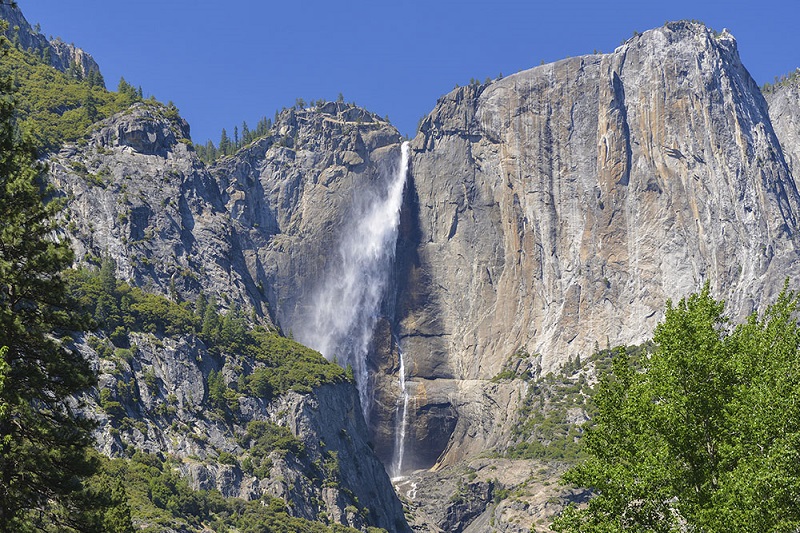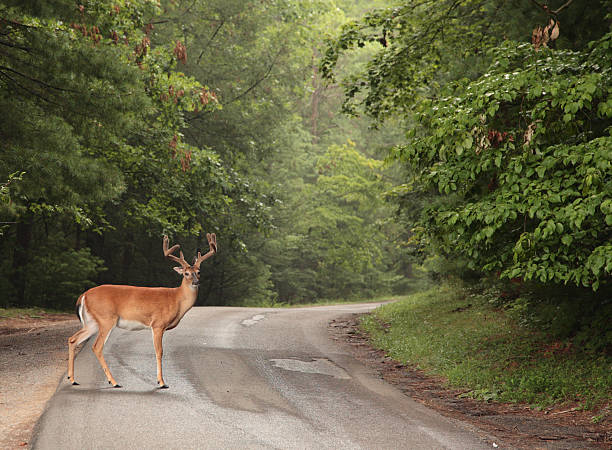The Yosemite National Park waterfalls are plentiful, with more than 25 falls to explore. Most of their snow melts in the spring, making it the ideal time to view waterfalls.
Discover some of the waterfalls in Yosemite, including their height, flow period, and viewing sites.
Many Yosemite National Park waterfalls can be seen from public views or along simple paths; however, some require trekking expertise.
Here’s a list of the waterfalls in Yosemite National Park, including the most notable ones out of the multiple waterfalls inside Yosemite:
1. Yosemite Falls
The highest waterfall in Yosemite National Park and one of the tallest in the world, the Yosemite Falls consists of three separate drops or sections:
- Upper Yosemite Fall (1,430 feet or 440 m)
- Middle Cascades (675 feet or 306 m)
- Lower Yosemite Fall (320 feet or 98 m)
The three drops together give this main waterfall a staggering total height of 2,425 feet or 739 m.
Situated in the Sierra Nevada of California, the best time to visit this fall is in late spring when the water flow is at its maximum.
At times, rare phenomena such as a moonbow or a rainbow waterfall at Yosemite National Park have also occurred, most notably at Yosemite Falls.
After a half-mile Yosemite Falls hike, you can access the base of the falls from pullouts along Northside Drive, parking lots at Yosemite Village, Yosemite Lodge, and Sentinel Bridge picnic spots.
Hikers have a variety of trails to choose from, with the most difficult hiking track being around 4 miles (6 km) long, which takes two to four hours to ascend.
The bridge near the base of the lower fall serves as the starting point of the most well-traveled and convenient Yosemite Falls hike trail.
Additionally, shuttle buses operate across Yosemite Valley to provide easy access from bigger parking locations, including Curry Village.
- Height: 2,425 feet (739 m)
- Flow: May is the peak flow month from around November to July.
- Viewpoint: Dozens of vantage points-
Swinging Bridge at Leidig Meadows
Southside Drive near Sentinel Rock
Glacier Point
Taft Point
2. Bridalveil Fall
Bridalveil is one of the first Yosemite National Park waterfalls you’ll encounter when you enter Yosemite Valley.
It is one of the most prominent Yosemite Falls that flows year-round.
Its prominence among the granite walls of the valley’s walls shouldn’t come as a surprise.
When there is a breeze, the mist gliding off resembles something like a “bride’s veil,” hence the name Bridalveil.
During light flow and heavy winds, the water does not hit the ground directly and drifts off to the sides.
The Ahwahneechee Native Americans, thus, gave this waterfall the name “Pohono,” which translates to “Spirit of the Puffing Wind.”
For an up-close experience, walk a quarter-mile on a paved trail from the nearest parking area and directly reach the waterfall’s base.
- Height: 617 feet (188 m)
- Flow: Year-round, with a peak in May
- Viewpoint: Tunnel View
3. Sentinel Falls
One of the largest waterfalls in Yosemite, Sentinel Falls, consists of six distinct drops.
From spring to early summer, it cascades down from Sentinel Rock on the park’s south side into the Yosemite Valley below.
It can be viewed from multiple vantage points during these months but typically dries out by July.
- Height: 1,920 feet (590 m)
- Flow: May is the highest flow month from around March through June.
- Viewpoint: Sentinel Beach or near Four Mile Trailhead
4. Ribbon Fall
This tallest single-drop waterfall in North America flows off El Capitan’s western side.
Early spring is a lovely time to see Ribbon Fall, mostly fed by snowmelt.
It is one of the most unique Yosemite National Park waterfalls, as it forms an ice cone at its base in the winter.
- Height: 1,612 feet (491 m)
- Flow: Roughly from March to June, peak in May
- Viewpoint: Southside Drive
5. Horsetail Fall
The Horsetail Fall, illuminated by the sun and commonly known as the ‘Firefall,’ is a treat for photographers, tourists, and locals alike.
This popular Yosemite National Park fire waterfall natural phenomenon occurs in February when the setting sun lights the fall at the perfect angle and the water appears to be on fire.
Snowmelt or rain provides the water for Yosemite’s second-highest entirely airborne waterfall, which drops in two streams: the eastern drop (1,540 feet) and the western one (1,570 feet).
- Height: 1,570 feet (480 m)
- Flow: Roughly from December to April
- Viewpoint: El Capitan picnic area or Northside Drive turnouts
6. Wapama Falls
Located on the northern wall of Hetch Hetchy Valley, one of the best waterfalls in Yosemite National Park, Wapama Falls consists of one primary drop.
Although it appears to have several distinct steps, in reality, there is only one continuous drop
Aptly known as “the Yosemite Falls of Hetch Hetchy,” it is the second-most powerful waterfall in California behind Yosemite Falls.
This is the best fall to visit for an impromptu trip to the park, as Hetch Hetchy is the only Yosemite area that doesn’t require a park reservation.
A fairly straightforward 2.5-mile (4 km) hike that starts by crossing the O’Shaughnessy Dam and moving via a tunnel cut through the cliff is required for closer views.
In Yosemite National Park waterfall hike for Wapama Falls is the easiest, with a short roundtrip that is simply negotiated.
The first footbridge at the fall’s base offers the most outstanding views. Cross the bridge to cool off in the fall’s showers.
- Height: 1,286 feet (392 meters)
- Flow: All year with peak flow in May
- Viewpoint: O’Shaughnessy Dam parking lot
7. Illilouette Fall
The least visited of the major waterfalls in Yosemite National Park due to its rather hard-to-access location.
The fall has relatively limited viewpoints.
It is visible from the John Muir Trail between Happy Isles and the Vernal Falls bridge but may completely vanish from this perspective during low-flow months.
It is difficult to reach the base of this fall as the confined canyon is rocky and frequently filled with rapids during the rainy season. The Wawona Road and Glacier Point Road lead to the fall, about 30 circuitous miles from Yosemite Village.
- Height: 365 feet (111 m)
- Flow: Year-round with a late May peak.
- Viewpoint: Glacier Point
8. Chilnualna Falls
On Chilnualna Creek, the southernmost part of Yosemite National Park, the Chilnualna Falls consists of three major drops.
The Wawona portion of the park offers waterfall explorers one worthwhile opportunity.
Ideally, visit when the water levels are at their highest, typically in late spring and early summer.
The trailhead for the falls is located at the end of Chilnualna Creek Road in Wawona’s easternmost region.
The 8.2 miles (13 km) round trip will take about 5-6 hours, but the sights of the falls and Wawona Dome make the effort worthwhile.
- Height: 690 feet (210 m)
- Flow: All year, with peak flow in May
- Viewpoint: Chilnualna Falls Trailhead, Chilnualna Creek Road
9. Nevada Fall
Situated at the highest point on the Mist Trail, the Nevada Fall, commonly called the ‘great staircase,’ is easily recognized due to its distinct bent shape.
The sheer intensity of the water hitting the granite produces a turbulent appearance akin to whitewater and a large volume of mist, giving it the name “snowy” in Spanish.
Using the John Muir Trail, you can trek to the top of the fall on the Merced River beneath the enormous granite dome, Liberty Cap.
- Height: 594 feet (181 m)
- Flow: Year-round, with a peak in late May
- Viewpoint: Glacier Point
10. Vernal Fall
Close to the Nevada Fall, on the Merced River, the Vernal Fall flows all year long.
One of the shortest trails in Yosemite is the Mist Trail, beginning at the Happy Isles and leading to the waterfall’s base.
During periods of heavy flow, which tend to occur in the spring, you might get drenched when you cross the waterfall’s mist.
One can relax and unwind after the trek at a water body at the top, Emerald Pool.
- Height: 317 feet (96.6 m)
- Flow: Peak flow occurs in late May; however, water flows continue throughout the year until mid to late summer, when it narrows and splits into one to three falls.
- Viewpoint: Glacier Point
11. Royal Arch Cascade
Situated on the north side of Yosemite Valley, the Royal Arch Cascade falls flow extensively during the snow melt season and occasionally after heavy rainstorms.
It is one of the easily missed waterfalls of Yosemite which consists of one or more threads of water flowing down the solid granite rock close to The Royal Arches.
To reach the base of the fall, take the trail from the Ahwahnee Hotel to Mirror Lake.
- Height: 1,275 feet (389 m)
- Flows: Approximately December through April
- Viewpoint: Ahwahnee Bridge, Yosemite Valley
12. Silver Strand Falls
Yosemite Valley’s Silver Strand Falls is the westernmost waterfall in Yosemite National Park.
This fall between Old Inspiration Point and Stafford Point is where Meadow Brook enters Yosemite Valley after draining from a tiny valley north of Badger Pass.
From the viewpoint of Tunnel View, look up on the Yosemite Valley wall to see one of Yosemite’s most overlooked falls.
Inspiration Falls, Meadow Brook Falls and Widow’s Tears are some other names for this fall, which usually runs dry by early June.
- Height: 560 feet (171 meters)
- Flows: Around December to April
- Viewpoint: Tunnel View along the Wawona Road
FAQs
How many waterfalls are in Yosemite National Park?
There are more than 25 waterfalls in Yosemite National Park, each providing a different scenic view.
What are the main waterfalls in Yosemite?
Yosemite Falls, Bridalveil Falls, Sentinel Falls, and the other waterfalls mentioned in the article are the most popular ones in Yosemite.
Horsetail Fall is also very famous and is known as ‘Yosemite Fire Waterfall’ due to the rare burning appearance of the waterfall when sunlight strikes it at a certain angle.
Why is Yosemite Falls famous?
Yosemite Falls is famous because it is made up of three different drops. The upper fall, middle cascades and lower fall combine for this 2425 ft (740 m) tall waterfall.
What are three facts about Yosemite Falls?
Yosemite Falls is the tallest waterfall in Yosemite National Park and North America.
It is made of three separate drops – The Upper Fall, the Middle Cascades, and The Lower Fall.
The waterfall is fed by snow. In winter, a giant ice cone is formed at the bottom of Upper Fall.


